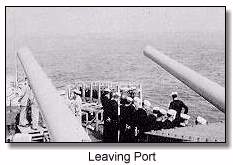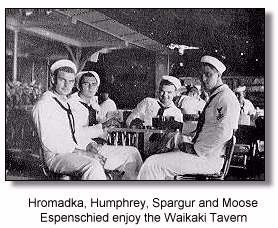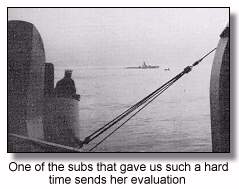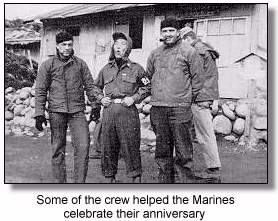 It was Monday, sunny and clear,
as the crew went to quarters for muster. The last liberty in the States
was over and at 1000 all departments reported ready for getting underway.
A short time later all lines were clear and we led the way out between
Pier 1 and the Navy Yard Mole. All hands top side took a last look at the
dummy hanging from the square-rigged sailing vessel tied at the Pier and
then contemplated their future.
It was Monday, sunny and clear,
as the crew went to quarters for muster. The last liberty in the States
was over and at 1000 all departments reported ready for getting underway.
A short time later all lines were clear and we led the way out between
Pier 1 and the Navy Yard Mole. All hands top side took a last look at the
dummy hanging from the square-rigged sailing vessel tied at the Pier and
then contemplated their future.
The new men wondered and the old hands worried, for the DeHaven was
returning to the Western Pacific for the third time since the start of
Korean hostilities. The previous tours had seen her visit Inchon with the
famous "Sitting Ducks", on patrol along the West Coast, working
along the Bomb-line and with Task Force 77. Her fine record was known to
all; and, even though two thirds of her crew were new, all hands were
certain this cruise would be just as successful as the previous ones.
On clearing the breakwater the word was passed, "Now set the
Condition three watch". Old hands muttered under their breath, and
new men stumbled uncertainly to their stations as the training began.
There would be drills and more drills before the ship would be completely
battle ready, and this was our last chance.
We joined the Los Angeles and Oriskany off San Diego and set our course
for Pearl, the Swenson and ourselves taking the usual destroyer screening
stations. Inter-ship exercise began, and by the time the final
"proceed independently to enter port" was received and we
started into the Pearl Harbor Channel, all hands had an idea of what would
be expected in the coming Task Force Operations.
 The
Hawaiian weather was just like the travel posters and all hands were ready
to make the best use of our time in port. Many of the crew saw Oahu
through organized tours, while others were content just to spend their
time at the more famous spots. In the morning it was evident that many had
fallen victim to the tropical climate and its misleading impression of
alcoholic capacity.
The
Hawaiian weather was just like the travel posters and all hands were ready
to make the best use of our time in port. Many of the crew saw Oahu
through organized tours, while others were content just to spend their
time at the more famous spots. In the morning it was evident that many had
fallen victim to the tropical climate and its misleading impression of
alcoholic capacity.
In spite of the big heads our training continued as we chased
submarines and conducted gunnery exercises on Kahoalawake Island. For many
this was the first time the guns were fired, but the results were
surprisingly good. We had our share of plane guard too, as we chased the
Oriskany during carrier operations.
All was not training, however, for we shared an air-sea rescue task
with the Mansfield. It involved running at full speed all night long to
participate in the down rescue of two men who had parachuted from their
Navy dive-bomber. One man required the service of the squadron doctor, as
he lay injured on the cliff of one of the islands.
 After seventeen days we took
our leave from the islands and headed westward with the Swenson and
Oriskany. More drills and training, including several new methods of
fueling, plus navigational assist to a group of air force jets
island-hopping their way to Japan, and then we were in Yokosuka.
After seventeen days we took
our leave from the islands and headed westward with the Swenson and
Oriskany. More drills and training, including several new methods of
fueling, plus navigational assist to a group of air force jets
island-hopping their way to Japan, and then we were in Yokosuka.
The new men hardly had a chance to get acquainted for 36 hours later
"Duty called" and we sailed with the rest of DESDIV 91 to take
our individual post with Task Force 95. Our "Call" took us along
the South coast of the Japanese Island, through the beautiful Shimoniseki
Straits to the Songjin-Chongjin area of the Korean east coast. Shortly
after our arrival the Captain relieved as Unit Commander and for the next
36 days we coordinated the efforts of the several "UN" ships in
their patrol and interdiction activities.
We remember the increasing cold of the approaching Korean winter, the
long night train-hunting, the patrols close to the Siberian border and the
days of pounding away at the North Korean supply routes. On one of the
quiet days all hands had the opportunity to visit Yongdo and the
"shutter bugs" were in their glory.
 We helped the Marines
celebrate their birthday and gave the shore fire control party a chance to
"live off the land and 'K' rations", for a few days.
We helped the Marines
celebrate their birthday and gave the shore fire control party a chance to
"live off the land and 'K' rations", for a few days.
We got used to sleeping through the night firing when we shot
"Stars" patrolling the slot, fired night interdiction and put
harassing fire on sections of railroad track undergoing night repairs. We
felt the satisfaction of helping the Canadian destroyer, Crusader, and the
Dutch destroyer, Piet Hein, destroy the trains they had stopped, as well
as the distress of failure after chasing a train for many miles only to
have it escape into a tunnel.
There were other highlights. On October 29th, LT. Tom Davenport, from
the Essex, ditched his flak-riddled dive bomber off the DeHaven's bow and
the boat crew had him on deck in eleven minutes. On November 1st we went
to the assistance of the Vammen which had tangled with Red shore
batteries. The days of replenishing when we received that letter from home
were all highlights.
The arrival of our relief, the Rooks, was a big day and after taking
them on a tour of all the better shooting galleries we departed to rejoin
DESDIV 91. The next ten days were spent with the carriers of Task Force 77
where we had a chance to really show our seamanship. The OOD and Combat
were kept busy as the Force went through its squads east and west. The
rest of the crew had their chance with replenishment and transfers. There
were surprise "Drill Magentas" and "AA" shoots during
holiday routine to keep us alert, and when we finally were relieved to
proceed to port not a dissenting voice was heard.
Continued